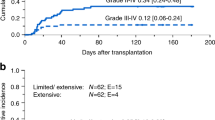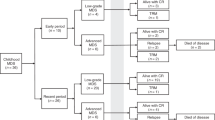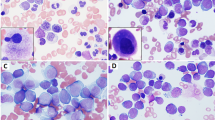Abstract
Summary:
Pediatric acute myeloid leukemia (AML) or myelodysplastic syndrome (MDS) with monosomy 7 is associated with poor disease-free survival when treated by conventional chemotherapy, immunosuppression or supportive measures. Hematopoietic stem cell transplant (HSCT) may improve outcomes; however, data to support this are limited. To better understand the curative potential of HSCT in these patients, all cases of AML and MDS with monosomy 7 treated by two transplant programs (1992 to present) were reviewed. A total of 16 patients were treated, all by allogeneic HSCT. Primary diagnoses were MDS (N=5), therapy-related MDS (N=3), AML (N=5) and therapy-related AML (N=3). In all, 11 patients (69%) survive event-free at 2 years with median follow-up of 986 days (range 330–2011 days). Toxicity caused deaths of the five nonsurviving patients, four of whom were transplanted with active leukemia. Allogeneic HSCT is effective therapy for childhood AML and MDS associated with monosomy 7, particularly for patients with AML in complete remission and MDS.
This is a preview of subscription content, access via your institution
Access options
Subscribe to this journal
Receive 12 print issues and online access
$259.00 per year
only $21.58 per issue
Buy this article
- Purchase on Springer Link
- Instant access to full article PDF
Prices may be subject to local taxes which are calculated during checkout

Similar content being viewed by others
References
Wheatley K, Burnett A, Goldstone A et al. A simple, robust, validated and highly predictive index for the determination of risk-directed therapy in acute myeloid leukaemia derived from the MRC AML 10 trial. Br J Haematol 1999; 107: 69–79.
Baranger L, Baruchel A, Leverger G et al. Monosomy-7 in childhood hemopoietic disorders. Leukemia 1990; 4: 345–349.
Passmore SJ, Hann IM, Stiller CA et al. Pediatric myelodysplasia: a study of 68 children and a new prognostic scoring system. Blood 1995; 85: 1742–1750.
Hasle H, Aric M, Basso G et al. Myelodysplastic syndrome, juvenile myelomonocytic leukemia, and acute myeloid leukemia associated with complete or partial monosomy 7. Leukemia 1999; 13: 376–385.
Leverger G, Bernheim A, Daniel M et al. Cytogenetic study of 130 childhood acute nonlymphocytic leukemias. Med Pediatr Oncol 1988; 16: 227–232.
Hasle H . Myelodysplastic syndromes in childhood. Classification, epidemiology, and treatment. Leuk Lymphoma. 1994; 13: 11–26.
Woods WG, Kobrinsky N, Buckley JD et al. Timed-sequential induction therapy improves postremission outcome in acute myeloid leukemia: a report from the Children's Cancer Group. Blood 1996; 87: 4979–4989.
Capizzi RL, Poole M, Cooper MR et al. Treatment of poor risk acute leukemia with sequential high-dose AraC and asparaginase. Blood 1984; 63: 694–700.
Kaplan E, Meier P . Nonparametric estimation from incomplete observations. J Am Stat Assoc 1958; 53: 457.
Lansky SB, List MA, Lansky LL et al. The measurement of performance in childhood cancer patients. Cancer 1987; 60: 1651–1656.
Hunger SP, Sun T, Boswell AF et al. Hyperdiploidy and E2A-PBX1 fusion in an adult with t(1;19)+ acute lymphoblastic leukemia: case report and review of the literature. Genes Chromosomes Cancer 1997; 20: 392–398.
Mitelman F . ISCN (1995). An International System for Human Cytogenetic Nomenclature. S Karger: Basel, 1995.
Soiffer RJ, Murray C, Gonin R, Ritz J . Effect of low-dose interleukin-2 on disease relapse after T-cell-depleted allogeneic bone marrow transplantation. Blood 1994; 84: 964–971.
Woods WG, Neudorf S, Gold S et al. A comparison of allogeneic bone marrow transplantation, autologous bone marrow transplantation, and aggressive chemotherapy in children with acute myeloid leukemia in remission: a report from the Children's Cancer Group. Blood 2001; 97: 56–62.
Chang M, Raimondi SC, Ravindranath Y et al. Prognostic factors in children and adolescents with acute myeloid leukemia (excluding children with Down syndrome and acute promyelocytic leukemia): univariate and recursive partitioning analysis of patients treated on Pediatric Oncology Group (POG) Study 8821. Leukemia 2000; 14: 1201–1207.
Guinan EC, Tarbell NJ, Tantravahi R, Weinstein HJ . Bone marrow transplantation for children with myelodysplastic syndromes. Blood 1989; 73: 619–622.
Groupe Français de Cytogénétique Hématologique. Forty-four cases of childhood myelodysplasia with cytogenetics, documented by the Groupe Français de Cytogénétique Hématologique. Leukemia 1997; 11: 1478–1485.
Kardos G, Baumann I, Passmore S et al. Refractory anemia in childhood: a retrospective analysis of 67 patients with particular reference to monosomy 7. Blood 2003; 102: 1997–2003.
Webb D, Passmore S, Hann I et al. Results of treatment of children with refractory anemia with excess blasts (RAEB) and RAEB in transformation (RAEBt) in Great Britain 1990–99. Br J Haematol 2002; 117: 33–39.
Woods W, Barnard D, Alonzo T et al. Prospective study of 90 children requiring treatment for juvenile myelomonocytic leukemia or myelodysplastic syndrome: A report from the Children's Cancer Group. J Clin Oncol 2002; 20: 434–440.
Grimwade D, Walker H, Oliver F et al. The importance of diagnostic cytogenetics on outcome in AML: analysis of 1,612 patients entered into the MRC AML 10 trial. Blood 1998; 92: 2322–2333.
Luna-Fineman S, Shannon KM, Atwater SK et al. Myelodysplastic and myeloproliferative disorders of childhood: a study of 167 patients. Blood 1999; 93: 459–466.
Sasaki H, Manabe A, Kojima S et al. Myelodysplastic syndrome in childhood: a retrospective study of 189 patients in Japan. Leukemia 2001; 15: 1713–1720.
Vardiman J, Harris N, Brunning R . The World Health Organization classification of the myeloid neoplasms. Blood 2002; 100: 2292–2302.
Hasle H, Niemeyer CM, Chessels HM et al. A pediatric approach to the WHO classification of myelodysplastic and myeloproliferative diseases. Leukemia 2003; 17: 277–282.
Author information
Authors and Affiliations
Corresponding author
Rights and permissions
About this article
Cite this article
Trobaugh-Lotrario, A., Kletzel, M., Quinones, R. et al. Monosomy 7 associated with pediatric acute myeloid leukemia (AML) and myelodysplastic syndrome (MDS): successful management by allogeneic hematopoietic stem cell transplant (HSCT). Bone Marrow Transplant 35, 143–149 (2005). https://doi.org/10.1038/sj.bmt.1704753
Received:
Accepted:
Published:
Issue Date:
DOI: https://doi.org/10.1038/sj.bmt.1704753
Keywords
This article is cited by
-
Improved outcomes of allogeneic hematopoietic stem cell transplantation including haploidentical transplantation for childhood myelodysplastic syndrome
Bone Marrow Transplantation (2020)
-
ETV6–ABL1 fusion combined with monosomy 7 in childhood B-precursor acute lymphoblastic leukemia
International Journal of Hematology (2018)
-
−7/7q− syndrome in myeloid-lineage hematopoietic malignancies: attempts to understand this complex disease entity
Oncogene (2015)
-
Analysis of risk factors influencing outcome in children with myelodysplastic syndrome after unrelated cord blood transplantation
Leukemia (2011)
-
Hematopoietic stem cell transplantation for advanced myelodysplastic syndrome in children: results of the EWOG-MDS 98 study
Leukemia (2011)



